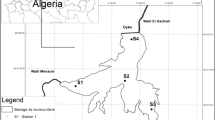Abstract
The distribution of phytoplankton species of a tropical blackwater reservoir is discussed on the basis of spatial differences in water composition and of species abundance and diversity. Spatial heterogeneity in water composition identified three different environments within the reservoir itself: (1) strongly colored waters, high turbidity and iron concentrations at the inflow; (2) calcium enriched, nearly uncolored waters at El Pao Bay; (3) lightly colored water, higher transparency and a higher ratio monovalent to divalent cations in the main body of the reservoir. Three corresponding phytoplankton associations were found. Principal Component Analysis helped to explore the relationship of particular species with the abiotic factors. Among them, water color, turbidity, and mineralization proved to be determinant in habitat diversification.
Similar content being viewed by others
References
APHA (American Public Health Association), 1975. Standard Methods for the Examination of Water and Waste Water. APHA; N.Y., 1189 pp.
Castro, L. & S. Gorzula, 1986. The interrelations of the Caroni River Basin ecosystems and hydroelectric power projects. Interciencia 11: 272–277.
Chu, S. P., 1942. The influence of the mineral composition of the medium on the growth of plankton algae. I. Methods and culture media. J. Ecol. 30: 284–325.
Kovach, W. L., 1990. A multivariate statistical package. MVSP Sharware. ver. 2.0.a.
Croome, R. L. & P. A. Tyler, 1988. Phytoflagellates and their ecology in Tasmanian polyhumic lakes. Hydrobiologia 161 (Dev. Hydrobiol. 45): 245–253.
Cuadras, C. M., 1979. Métodos de Análisis Multivariante. EUNIBAR. Barcelona, 639 pp.
De Haan, H. & T. De Boer, 1986. Geochemical aspects of aqueous iron, phosphorus and dissolved organic carbon in the humic lake Tjeukemeer, The Netherlands. Freshwat. Biol. 16: 661–672.
De Haan, H.; T. De Boer, J. Voerman, H. A. Kramer & O. F.R. Van Tongeren, 1989. Size class distribution of dissolved (<200 nm) nutrients and essential metals in shallow, eutrophic and humic lakes. Verh. int. Ver. Limnol: 24: 289–501.
Frimmel, F. H. & R. F. Christman, 1988. Humic substances and their role in the environment. Dahlem Workshop Reports, 271 pp.
Frontier, S., 1976. Etude de la décroissance des valeurs propres dans une analyse en composantes principales: comparaison avec le modèle du baton brisé. J. exp. mar. Biol. Ecol. 25: 67–75.
Gamble, D. S., C. H. Langford & A. W. Underdown, 1984. The interrelationship of aggregation and cation binding of fulvic acid. In C. J. M. Kramer & J. C. Duinker (eds), Complexation of Trace Metals in Natural Waters. ISBN 90–247–2973.
Gjessing, E. T., 1976. Physical and chemical characteristics of aquatic humus. Ann Arbor Science Publishers Inc: Ann Arbor, Michigan, 120 pp.
Guilford, S. J., F. P. Healey & R. E. Hecky, 1987. Depression of primary production by humic matter and suspended sediments in limnocorral experiments at Southern Indian Lake, Northern Manitoba. Can. J. Fish. aquat. Sci. 45: 1408–1417.
Hideux, M., 1977. Traitement numérique des donées palynologiques a des fins taxonomiques. Grana 16: 85–97.
Ilmavirta, V., 1984. The ecology of flagellated phytoplankton in brown-water lakes. Verh. int. Ver. Limnol. 22: 817–821.
Jackson, A. T. & R. E. Hecky, 1980. Depresssion of Primary Productivity in Humic Matter in Lake and Reservoir waters of the Boreal Forest Zone: Can. J. Fish. aquat. Sci. 37: 2300–2317.
Jones, R. I. & L. Arvola, 1984. Light penetration and some related characteristics in small forest lakes in Southern Finnland. Verh. int. Ver. Limnol. 22: 811–816.
Jones, R. I., 1992. The influence of humic substances on lacustrine planktonic food chains. Hydrobiologia 229 (Dev. Hydrobiol. 73): 73–91.
Lewis, W. M. & F. H. Weibezahn, 1976. Chemistry, energy flow and community structure in some Venezuelan freshwaters: Arch. Hydrobiol. Suppl. 50: 145–207.
Pearsall, W. H., 1922. A suggestion as to factors influencing the distribution of free-floating vegetation. J. Ecol. 9: 241–253.
Pearsall, W. H., 1923. Phytoplankton in the English lakes. II. The composition of the phytoplankton in relation to dissolved substances. J. Ecol. 20: 241–262.
Reynolds, C. S., 1990: The ecology of freshwater phytoplankton. Cambridge University Press, N.Y., 383 pp.
Riehl, W., A. Infante & I. Massa, 1991. Desmidias del Embalse de Guri, Venezuela. Acta Cient. Venez. 38: 106–121.
Ryan, D. K. & J. H. Weber, 1982. Copper (II) complexing capacities of natural waters by fluorescence quenching. Envir. Sci. Technol. 16: 855–872.
Salonen, K., K. Kononen & L. Arvola, 1983. Respiration of plankton in two small, polyhumic lakes. Hydrobiologia 101 (Dev. Hydrobiol. 13): 65–70.
Salonen, K., T. Kairesalo & R. I. Jones (eds), 1992. Dissolved Organic Matter in Lacustrine Ecosystems: Energy Source and System Regulator. Developments in Hydrobiology 73. Kluwer Academic Publishers, Dordrecht, 291 pp. Reprinted from Hydrobiologia 229.
Sioli, H., 1965. Bemerkung zur Typologie Amazonischer Fluesse. Amazoniana, 1: 74–83.
Stewart, A. J. & R. G. Wetzel, 1982. Influence of dissolved humic substances on carbon assimilation and alkaline phosphatase activity in natural algal-bacterial assemblages. Freshwat. Biol. 12: 369–380.
Talling, J. F. & I. B. Talling, 1965. The chemical composition of African lake waters. Int. Revue ges. Hydrobiol. 50: 421–463.
Tipping, E., 1981. The adsorption of aquatic humic substances by iron oxides. Geoch. Cosmoch. Acta 45: 191–199.
Vegas-Vilarrúbia, T., J. Paolini & R. Herrera, 1988. A physicochemical survey of blackwater rivers from the Orinoco and the Amazon basins in Venezuela. Arch. Hydrobiol. 111: 491–506.
Vegas-Vilarrúbia, T. & M. Cova, 1993. Estudio sobre la distribución y ecología de macróficos acuáticos en el Embalse de Guri. Interciencia 18: 77–82.
Vegas-Vilarrúbia, T., 1994. Water chemistry of the Guri Reservoir (rainy season 1989). Relationships between humic color and aqueous iron and their limnological importance. Archiv Hydrobiologie: (in press).
Wetzel, R., 1981. Limnología. Ed. Omega, Barcelona, 679 pp.
Author information
Authors and Affiliations
Rights and permissions
About this article
Cite this article
Vegas-Vilarrúbia, T. Distribution of the phytoplankton from the Guri Reservoir (Venezuela). Hydrobiologia 310, 33–46 (1995). https://doi.org/10.1007/BF00008181
Received:
Revised:
Accepted:
Issue Date:
DOI: https://doi.org/10.1007/BF00008181




